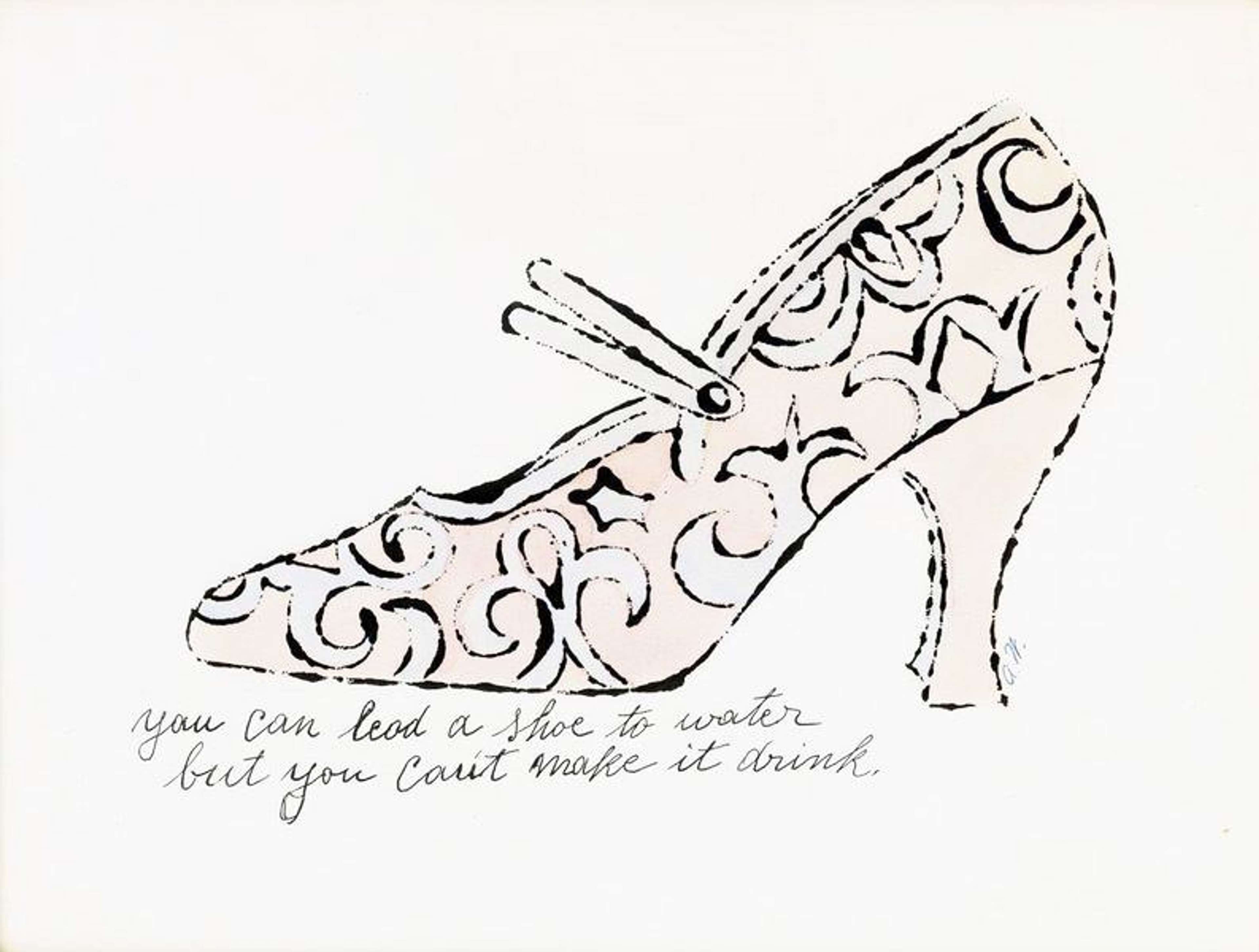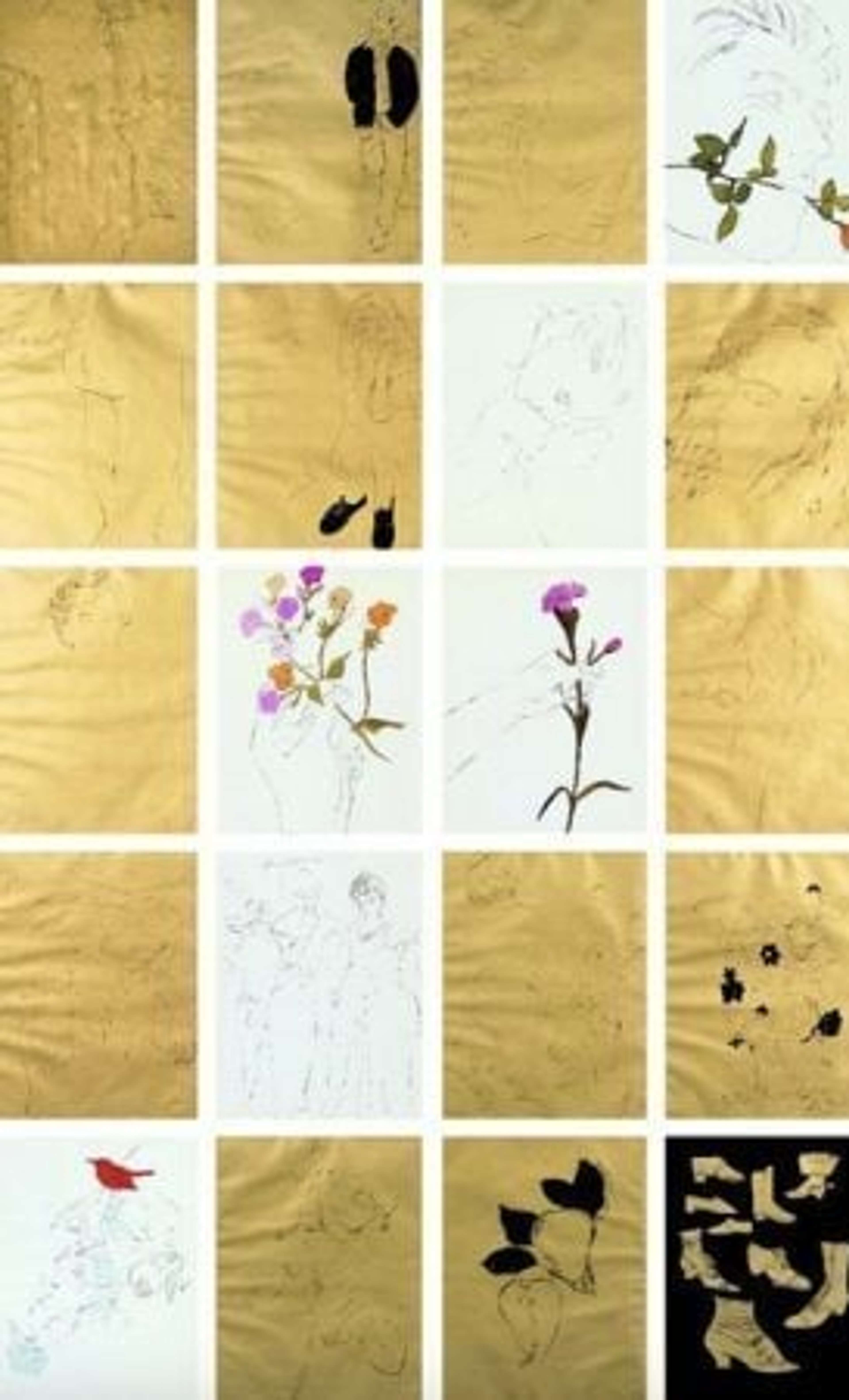 A Gold Book, Man With Rose (F. & S. IV.108) © Andy Warhol 1957
A Gold Book, Man With Rose (F. & S. IV.108) © Andy Warhol 1957
Interested in buying or selling
Andy Warhol?

Andy Warhol
487 works
A Gold Book is one of Andy Warhol's earliest print series, and produced to send to potential employers. Testament to Warhol's early talents as a commercial illustrator, the series shows the development of the style and subject matter which would come to define the Pop Artist.
The series was created as a self-promotional portfolio.
 A Gold Book, Hand With Carnation, (F. & S. IV.115) © Andy Warhol 1957
A Gold Book, Hand With Carnation, (F. & S. IV.115) © Andy Warhol 1957Back in the 1950s, it was customary for commercial artists to send portfolios of their work to editors and art directors for exposure. Each edition of A Gold Book was addressed to a different person, as a way to maximise Warhol's exposure in the commercial industry. A copy of A Gold Book owned by MoMA, for example, is addressed Russell Lynes, an editor at Harper's Bazaar.
The series was inspired by Southeast Asian lacquered furniture
 Image © Christie's / A Gold Book © Andy Warhol 1957
Image © Christie's / A Gold Book © Andy Warhol 1957During a seven week journey around the world in 1956, Warhol visited Bangkok and was instantly inspired by the rich visual culture he saw there. The style and gold-leaf in this series was informed by Southeast Asian gold-leaf lacquered furniture with contrasting black imagery. The series visualises the effect of Warhol's personal experiences on his artwork, fairly early on in his career.
The series is typical of Warhol's early style as a commercial illustrator.
 Image © Christie's / A Gold Book © Andy Warhol 1957
Image © Christie's / A Gold Book © Andy Warhol 1957In both its style and subject matter, A Gold Book is reminiscent of Warhol's early printed works in the 1950s. While living with his mother in New York, Warhol worked as a commercial illustrator for shoe companies and fashion publications. A gold-leaf and black lithograph of shoes from this series is particularly comparable with his La Recherche Du Shoe Perdu series, and evidences his mastery over the shoe illustration.
Each print in the series was signed by Warhol's mother, Julia Warhola.
 You Can Lead A Shoe To Water But You Can’t Make It Drink © Andy Warhol 1950
You Can Lead A Shoe To Water But You Can’t Make It Drink © Andy Warhol 1950Like La Recherche Du Shoe Perdu and Cats Named Sam, the prints in this series were hand-inscribed by Warhol's mother. Warhola's calligraphic inscriptions are an early instance of collaboration in Warhol's oeuvre, something which became increasingly important at the height of his career.
A Gold Book is one of Warhol's earliest print series.
 Cats Named Sam IV 58 © Andy Warhol 1954
Cats Named Sam IV 58 © Andy Warhol 1954Executed in 1957, A Gold Book is one of the earliest sets of prints produced by Warhol. Though the Pop Artist did not venture into screen printing until the early 1960s, he developed his penchant for printing in lithography. The series shows us how Warhol's work was inspired by his commercial roots, which is maybe why print sets were such a recurring part of his oeuvre.
One print in the series depicts the actor James Dean.
 A Gold Book Cover © Andy Warhol 1957
A Gold Book Cover © Andy Warhol 1957A Gold Book is an early instance of Warhol's celebrity portraiture. Warhol depicted the actor James Dean in this series, rendered in black ink on a gold-leaf ground, with particular focus on his leather jacket. Created two years after Dean's death in a car accident in 1955, Warhol's lithograph is an homage to this American icon, and the first of many more to come.
Most of the compositions were traced from photographs.
 A Gold Book, Hand And Flowers (F. & S. IV.114) © Andy Warhol 1957
A Gold Book, Hand And Flowers (F. & S. IV.114) © Andy Warhol 1957Many of the works in this series were traced from photographs taken by Edward Wallowitch. Warhol's time-saving approach to printmaking is something he would carry forth and develop later in his career, and shaped his business-like approach to art production in the Factory.
The series foregrounds gay subcultures.
 A Gold Book, Man With Rose (F. & S. IV.108) © Andy Warhol 1957
A Gold Book, Man With Rose (F. & S. IV.108) © Andy Warhol 1957Warhol described the subjects in this series as “boys filles fruits and flowers shoes”. A Gold Book is an early instance of Warhol exploring romance, and a reference to the gay subculture that Warhol identified with.
Warhol used his blotted line technique to create this series.
 Shoe And Leg © Andy Warhol 1955
Shoe And Leg © Andy Warhol 1955In his early lithographic works, Warhol employed a blotting technique which allowed him to directly transfer his illustrations. Starting with a pencil drawing on non-absorbent paper, Warhol would delineate his images with a characteristic delicacy. This initial drawing would then be traced onto a new piece of paper, and inked with a fountain pen, before transferring the ink onto a second sheet of paper. The effect would leave a slightly broken, ’blotted’ line which we see in this series.
A Gold Book is an eclectic collection of different subjects.
 A Gold Book (complete set) © Andy Warhol 1957
A Gold Book (complete set) © Andy Warhol 1957Unlike his later print series which all followed a coherent theme, A Gold Book is a tapestry of sorts. From portraits, to hands holding flowers, to groups of people and objects, each print in this series is different. Perhaps Warhol created such a variety of compositions in A Gold Book to prove his talents and his unique approach to print.
